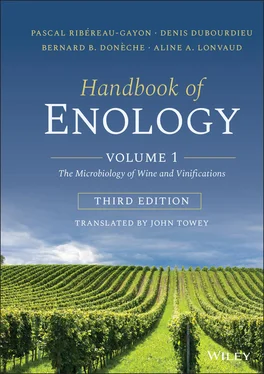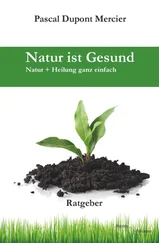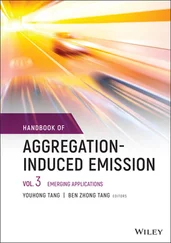1.8.3 Successive Classifications of the Genus Saccharomyces and the Position of Wine Yeasts in the Current Classification
Due to many changes in yeast classification and nomenclature since the beginning of taxonomic studies, wine‐related yeast names and their positions in the classification have often changed. This has inevitably resulted in some confusion for winemakers. Even the most recent enological textbooks (Fleet, 1993; Delfini, 1995; Boulton et al ., 1995) use a number of species names ( cerevisiae , bayanus , uvarum , etc.) attached to the genus name Saccharomyces to designate yeasts responsible for alcoholic fermentation. Although still in use, this enological terminology is no longer accurate to designate the species currently delimited by taxonomists.
The evolution of species classification for the genus Saccharomyces since the early 1950s ( Table 1.3) has created this difference between the naming of wine yeasts and current taxonomy. By taking a closer look at this evolution, the origin of the differences may be understood.
In Lodder and Kregger‐Van Rij (1952), the names cerevisiae , oviformis , bayanus , uvarum , etc., referred to a number of the 30 species of the genus Saccharomyces . Ribéreau‐Gayon and Peynaud (1960) considered that two principal fermentation species were found in wine: S. cerevisiae (formerly called ellipsoideus ) and Saccharomyces oviformis , which was encountered especially toward the end of fermentation and was considered more ethanol resistant. The difference in their ability to ferment galactose distinguished the two species: S. cerevisiae (Gal +) fermented galactose, whereas S. oviformis (Gal −) did not. According to the same authors, the species Saccharomyces bayanus was rarely found in wines. Although it possessed the same physiological fermentation and sugar assimilation characters as S. oviformis , its cells were more elongated, its fermentation was slower, and it displayed specific behavior toward growth factors. As for the species Saccharomyces uvarum , identified in wine by many authors, it differed from S. cerevisiae , S. oviformis , and S. bayanus because it could ferment melibiose.
In Lodder's following edition (1970), the number of species of the genus Saccharomyces increased from 30 to 41. Some species formerly grouped with other genera were integrated into the genus Saccharomyces . Moreover, several species names were considered to be synonyms and disappeared altogether. Such was the case of S. oviformis , which was moved to the species S. bayanus . Ribéreau‐Gayon et al . (1975) considered, however, that the distinction between S. oviformis and S. bayanus was of enological interest because of the different technological characteristics of these two yeasts. Nevertheless, by the early 1980s, most enology texts had abandoned the name S. oviformis and replaced it with S. bayanus .
TABLE 1.3 Evolution of the Nomenclature for the Saccharomyces Genus, 1952–2011 (Libkind et al. 2011)
Source: From Barnett et al . ( 2000), Lodder and Kregger‐Van Rij ( 1952), Lodder ( 1970), Kregger‐Van Rij ( 1984), and Kurtzman et al . ( 2011).
| 1952 |
1970 |
1984 |
2011 |
| Saccharomyces cerevisiae ⇒ Saccharomyces pastorianus Saccharomyces bayanus ⇒ Saccharomyces oviformis Saccharomyces logos Saccharomyces chevalieri ⇒ Saccharomyces fructuum Saccharomyces lactis Saccharomyces elegans Saccharomyces heterogenicus Saccharomyces fermentati Saccharomyces mellis Saccharomyces italicus ⇒ Saccharomyces steineri Saccharomyces pastori Saccharomyces carlsbergensis Saccharomyces uvarum ⇒ |
Saccharomyces cerevisiae Saccharomyces aceti Saccharomyces bayanus Saccharomyces capensis Saccharomyces prostoserdovii Saccharomyces chevalieri Saccharomyces coreanus Saccharomyces diastaticus Saccharomyces globosus Saccharomyces heterogenicus Saccharomyces hienipiensis Saccharomyces inusitatus Saccharomyces italicus Saccharomyces norbensis Saccharomyces oleaceus Saccharomyces oleaginosuss Saccharomyces uvarum |
Saccharomyces cerevisiae |
Saccharomyces arboricolus Saccharomyces bayanus a Saccharomyces cariocanus Saccharomyces cerevisiae Saccharomyces eubayanus Saccharomyces kudriavzevii Saccharomyces mikatae Saccharomyces paradoxus Saccharomyces pastorianus a Saccharomyces uvarum |
| Saccharomyces acidifaciens Saccharomyces bailii ⇒ Saccharomyces fragilis Saccharomyces delbrueckii ⇒ Saccharomyces marxianus Saccharomyces exiguus ⇒ Saccharomyces veronae Saccharomyces florentinus ⇒ Saccharomyces bisporus ⇒ Saccharomyces willianus Saccharomyces microellipsodes ⇒ |
Saccharomyces incompspicuus Saccharomyces amurcae Saccharomyces bailii Saccharomyces cidri Saccharomyces dairensis ⇒ Saccharomyces delbrueckii Saccharomyces eupagycus Saccharomyces exiguus ⇒ Saccharomyces fermentati Saccharomyces florentinus Saccharomyces bisporus Saccharomyces kloeckerianus Saccharomyces kluyveri ⇒ Saccharomyces microellipsodes Saccharomyces montanus Saccharomyces mrakii Saccharomyces pretoriensis |
Saccharomyces dairensis Saccharomyces exiguus Saccharomyces kluyveri |
|
| Saccharomyces rosei ⇒ Saccharomyces rouxii ⇒ |
Saccharomyces rosei Saccharomyces rouxii Saccharomyces saitoanus Saccharomyces telluris ⇒ Saccharomyces transvaalensis Saccharomyces unisporus ⇒ Saccharomyces vafer |
Saccharomyces telluris Saccharomyces unisporus Saccharomyces servazzii |
|
a Interspecific hybrids.
The new classification by Kregger‐Van Rij (1984), based on Yarrow's work on percentages of guanine and cytosine bases in yeast DNA, brought forth another important change in the designation of Saccharomyces species. Only seven species continued to exist, while 17 names became synonyms of S. cerevisiae . As with the preceding yeast classification, these yeast were differentiated by their sugar utilization profile ( Table 1.4), and some authors considered them to be races or physiological varieties of S. cerevisiae . However, this was nothing more than an artificial taxonomy without biological significance. Enologists took the habit of adding the varietal name to S. cerevisiae to designate wine yeasts: S. cerevisiae var. cerevisiae , var. bayanus , var. uvarum , var. chevalieri , etc. In addition, two species, bailii and rosei , were removed from the genus Saccharomyces and integrated into two other genera to become Zygosaccharomyces bailii and T. delbrueckii , respectively.
Based on recent advances in genetics and molecular taxonomy, the latest yeast classification (Kurtzman et al ., 2011) and recent studies (Libkind et al ., 2011) have again thrown the species delimitation of the genus Saccharomyces into confusion. There are now 10 species ( Table 1.3). The species Saccharomyces paradoxus , Saccharomyces arboricolus , Saccharomyces mikatae , and Saccharomyces eubayanus include strains initially isolated from tree exudates, insects, and soil (Naumov et al ., 1998, 2000a; Wang and Bai, 2008; Libkind et al ., 2011). Using genome analysis, Redzepovic has nevertheless identified a high percentage of S. paradoxus in Croatian grape microflora in Redzepovic et al . (2002).
Читать дальше












